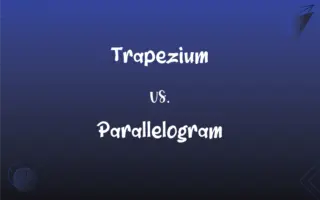Batch Fermentation vs. Continuous Fermentation: What's the Difference?
Edited by Aimie Carlson || By Harlon Moss || Published on February 19, 2024
Batch fermentation is a closed system where fermentation occurs in set amounts, while continuous fermentation involves ongoing input and output of materials.

Key Differences
Batch fermentation involves processing materials in specific, closed batches, contrasting with continuous fermentation, where the process runs uninterruptedly with constant input and output.
In batch fermentation, all ingredients are added at the start and the product is removed at the end of the process, unlike continuous fermentation where ingredients are continuously added and products removed.
Batch fermentation allows for flexibility in changing product types or batches, whereas continuous fermentation is more efficient for producing a consistent product over a longer period.
Monitoring and controlling conditions in batch fermentation is done per batch, while in continuous fermentation, it requires constant monitoring and adjustment.
Batch fermentation is suitable for small-scale production and research, whereas continuous fermentation is more suited for large-scale, industrial production.
ADVERTISEMENT
Comparison Chart
Process Duration
Defined start and end
Ongoing without a defined end
Ingredient Addition
All at start
Continuously during the process
Product Removal
After fermentation is complete
Continuously during the process
Flexibility in Production
More flexible for different products
Less flexible, suited for single product
Scale and Application
Suitable for small-scale and research
Better for large-scale industrial use
ADVERTISEMENT
Batch Fermentation and Continuous Fermentation Definitions
Batch Fermentation
Batch fermentation is ideal for experimental and variable production.
Small-scale wineries use batch fermentation to experiment with different grape varieties.
Continuous Fermentation
Continuous fermentation requires ongoing addition of ingredients.
In continuous fermentation, a dairy factory may continuously add milk for cheese production.
Batch Fermentation
Batch fermentation ends with the removal of the final product after processing.
Sourdough bread uses batch fermentation for each batch of dough.
Continuous Fermentation
Continuous fermentation demands continuous process monitoring.
Biofuel plants rely on continuous fermentation, constantly monitoring and adjusting conditions.
Batch Fermentation
Batch fermentation involves adding all ingredients at the process start.
In making yogurt, the milk and cultures are added at once in batch fermentation.
Continuous Fermentation
Continuous fermentation involves uninterrupted production.
Industrial ethanol production often uses continuous fermentation.
Batch Fermentation
Batch fermentation allows for the entire process to be controlled per batch.
Artisanal cheese production often relies on batch fermentation for quality control.
Continuous Fermentation
Continuous fermentation is suitable for large-scale, uniform product manufacturing.
Continuous fermentation is used in large breweries for consistent beer quality.
Batch Fermentation
Batch fermentation is a closed-system fermentation process.
Brewing beer typically uses batch fermentation in vats.
Continuous Fermentation
Continuous fermentation is characterized by steady product removal.
Pharmaceutical companies use continuous fermentation for constant antibiotic production.
FAQs
What is batch fermentation?
A fermentation process in a closed system with a defined start and end.
Can batch fermentation be used for different products?
Yes, it's flexible for various products.
Is continuous fermentation good for product consistency?
Yes, it maintains consistent product quality over time.
What defines continuous fermentation?
It's an ongoing fermentation process without a defined end, with continuous input and output.
How do batch and continuous fermentation differ in scale?
Batch is often used for small-scale, while continuous is for large-scale production.
When are products removed in batch fermentation?
After the fermentation cycle is complete.
Is continuous fermentation energy-efficient?
Yes, it can be more energy-efficient for long-term production.
How is ingredient addition different in batch fermentation?
All ingredients are added at the start in batch fermentation.
What's the cleaning process like in batch fermentation?
Equipment is cleaned after each batch.
How does continuous fermentation add ingredients?
Ingredients are continuously added during the process.
Is batch fermentation suitable for experimental production?
Yes, it's ideal for trials and small batches.
Can batch fermentation handle large volumes?
It's less efficient for very large volumes compared to continuous fermentation.
Can batch fermentation be automated?
Yes, but it typically requires more manual intervention than continuous fermentation.
How does product removal work in continuous fermentation?
Products are removed continuously during the process.
What industries use continuous fermentation?
Mainly large-scale industries like pharmaceuticals and biofuels.
Can batch fermentation be used for artisanal products?
Yes, it's often used for artisanal foods and beverages.
Is continuous fermentation flexible for different products?
It's less flexible and usually dedicated to a single product type.
How does batch fermentation control the process?
Control is applied per batch, allowing for adjustments in each cycle.
How is equipment maintenance managed in continuous fermentation?
It requires ongoing maintenance due to continuous operation.
What kind of monitoring does continuous fermentation require?
Continuous process monitoring and adjustment.
About Author
Written by
Harlon MossHarlon is a seasoned quality moderator and accomplished content writer for Difference Wiki. An alumnus of the prestigious University of California, he earned his degree in Computer Science. Leveraging his academic background, Harlon brings a meticulous and informed perspective to his work, ensuring content accuracy and excellence.
Edited by
Aimie CarlsonAimie Carlson, holding a master's degree in English literature, is a fervent English language enthusiast. She lends her writing talents to Difference Wiki, a prominent website that specializes in comparisons, offering readers insightful analyses that both captivate and inform.






































































